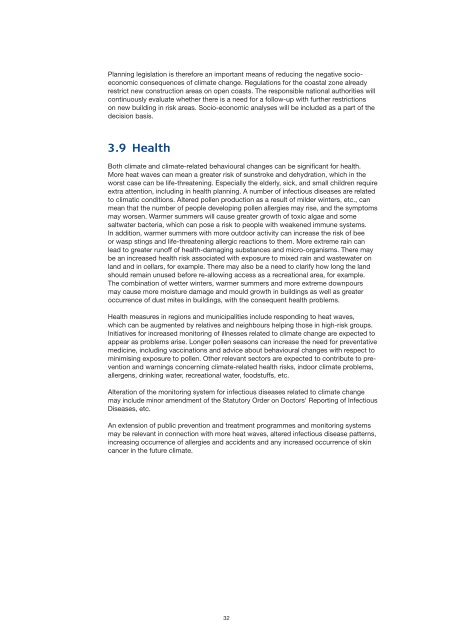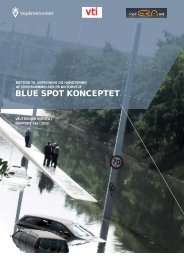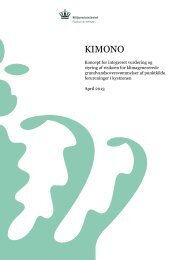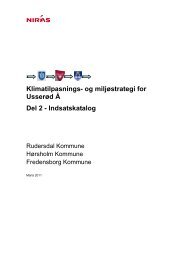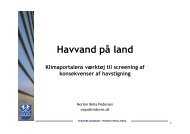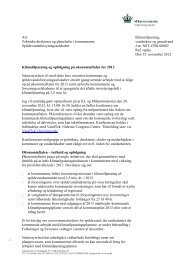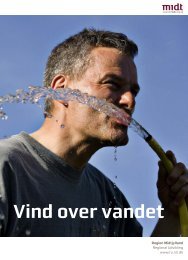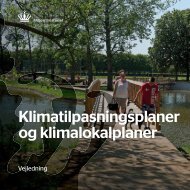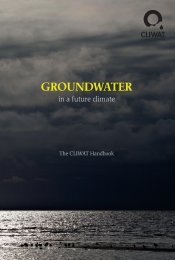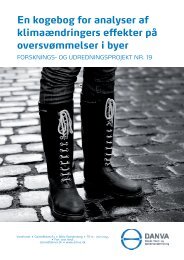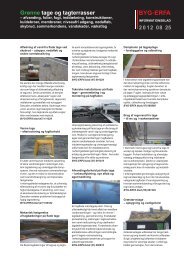Danish strategy for adaptation to a changing climate (Pdf)
Danish strategy for adaptation to a changing climate (Pdf)
Danish strategy for adaptation to a changing climate (Pdf)
Create successful ePaper yourself
Turn your PDF publications into a flip-book with our unique Google optimized e-Paper software.
Planning legislation is there<strong>for</strong>e an important means of reducing the negative socioeconomic<br />
consequences of <strong>climate</strong> change. Regulations <strong>for</strong> the coastal zone already<br />
restrict new construction areas on open coasts. The responsible national authorities will<br />
continuously evaluate whether there is a need <strong>for</strong> a follow-up with further restrictions<br />
on new building in risk areas. Socio-economic analyses will be included as a part of the<br />
decision basis.<br />
3.9 Health<br />
Both <strong>climate</strong> and <strong>climate</strong>-related behavioural changes can be significant <strong>for</strong> health.<br />
More heat waves can mean a greater risk of sunstroke and dehydration, which in the<br />
worst case can be life-threatening. Especially the elderly, sick, and small children require<br />
extra attention, including in health planning. A number of infectious diseases are related<br />
<strong>to</strong> climatic conditions. Altered pollen production as a result of milder winters, etc., can<br />
mean that the number of people developing pollen allergies may rise, and the symp<strong>to</strong>ms<br />
may worsen. Warmer summers will cause greater growth of <strong>to</strong>xic algae and some<br />
saltwater bacteria, which can pose a risk <strong>to</strong> people with weakened immune systems.<br />
In addition, warmer summers with more outdoor activity can increase the risk of bee<br />
or wasp stings and life-threatening allergic reactions <strong>to</strong> them. More extreme rain can<br />
lead <strong>to</strong> greater runoff of health-damaging substances and micro-organisms. There may<br />
be an increased health risk associated with exposure <strong>to</strong> mixed rain and wastewater on<br />
land and in cellars, <strong>for</strong> example. There may also be a need <strong>to</strong> clarify how long the land<br />
should remain unused be<strong>for</strong>e re-allowing access as a recreational area, <strong>for</strong> example.<br />
The combination of wetter winters, warmer summers and more extreme downpours<br />
may cause more moisture damage and mould growth in buildings as well as greater<br />
occurrence of dust mites in buildings, with the consequent health problems.<br />
Health measures in regions and municipalities include responding <strong>to</strong> heat waves,<br />
which can be augmented by relatives and neighbours helping those in high-risk groups.<br />
Initiatives <strong>for</strong> increased moni<strong>to</strong>ring of illnesses related <strong>to</strong> <strong>climate</strong> change are expected <strong>to</strong><br />
appear as problems arise. Longer pollen seasons can increase the need <strong>for</strong> preventative<br />
medicine, including vaccinations and advice about behavioural changes with respect <strong>to</strong><br />
minimising exposure <strong>to</strong> pollen. Other relevant sec<strong>to</strong>rs are expected <strong>to</strong> contribute <strong>to</strong> prevention<br />
and warnings concerning <strong>climate</strong>-related health risks, indoor <strong>climate</strong> problems,<br />
allergens, drinking water, recreational water, foodstuffs, etc.<br />
Alteration of the moni<strong>to</strong>ring system <strong>for</strong> infectious diseases related <strong>to</strong> <strong>climate</strong> change<br />
may include minor amendment of the Statu<strong>to</strong>ry Order on Doc<strong>to</strong>rs' Reporting of Infectious<br />
Diseases, etc.<br />
An extension of public prevention and treatment programmes and moni<strong>to</strong>ring systems<br />
may be relevant in connection with more heat waves, altered infectious disease patterns,<br />
increasing occurrence of allergies and accidents and any increased occurrence of skin<br />
cancer in the future <strong>climate</strong>.<br />
32


